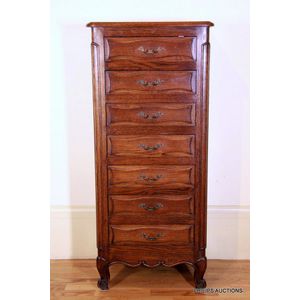Walnut Louis XV style buffet with marble top
You must be a subscriber, and be logged in to view price and dealer details.
Subscribe Now to view actual auction price for this item
When you subscribe, you have the option of setting the currency in which to display prices to $Au, $US, $NZ or Stg.
- Veneers - Veneers are thin sheets of well-figured timber that are glued under pressure to the surface of a cheaper timber for decorative effect, and then used in the making of carcase furniture.
Early veneers were saw-cut so were relatively thick, (up to 2 mm) but is was realised that saw cutting was wasteful, as timber to the equivilent of the thickness of the saw was lot on each cut.
A more efficient method was devised to slice the timber, either horizontally with a knife, or in a rotary lathe.
Flame veneer, commonly found in mahogany or cedar furniture, is cut from the junction of the branches and main trunk. So-called fiddleback veneers, where the grain is crossed by a series of pronounced darker lines, is usually cut from the outer sections of the tree trunk.
During the 17th and 18th centuries, and in much of the walnut marquetry furniture made during the latter part of the 19th century, the veneer was laid in quarters, each of the same grain, so that one half of the surface was the mirror image of the other.
The use of veneer allows many other decorative effects to be employed, including stringing, feather banding, cross banding, and inlaid decorative panels in the piece. The carcase over which veneer is laid is usually of cheaper timber such as pine, oak or, sometimes in Australia during the first half of the 19th century, red cedar.
The important thing to remember about veneers is that prior to about 1850 they were cut by hand, and were consequently quite thick - ranging up to about 2mm deep.
From the mid-19th century veneers were cut by machines and were almost wafer-thin. This is a critical point when trying to judge the approximate age of veneered furniture. - Pediment - The uppermost section of a tall usually double-heightened piece of cabinet furniture, surmounting the cornice. The pediment can take a variety of forms derived from the architecture of classical antiquity. A broken pediment is of triangular shape, however, the two raised sides do not meet at the apex but are 'broken' the gap between them often ornamented with an urn or finial. Swan-neck pediments are of similar form, although the uprights are gracefully arched, resembling a swan's neck. They are often found, for example, on longcase clocks.
- Ogee - A serpentine shape, usually convex at the upper part, concave at the lower. Mostly used to describe the front shapes of parts of carcass furniture, such as cornices, drawer fronts and feet.
- Breakfront - A design generally found in larger pieces of furniture, such as bookcases, wardrobes and some sideboards. The line of the front is interrupted by the middle section standing out from each end. In a reverse breakfront, the centre section is recessed behind each end. Breakfronted pieces are usually made in three sections the middle and the two wings which are held together by the cornice and pediment, and the plinth on which it stands. The sensible buyer should show caution before buying breakfront pieces, especially bookcases, which are highly desirable and expensive. Always check that the timber, colour, patination, backboards, decoration and thickness of the wood are same in each section.
- Mounts - Mounts are used to describe bronze, brass and ormolu adornments on furniture especially quality furniture in the rococo and classical revival style, and are also the cabinet makers' name for the metal fittings on furniture, such as hinges, locks and handles, and metal edges and guards which protect furniture from damage.
- Quarter Veneer - In preparation for production of quarter-sawn veneer, the log is first quartered, meaning it's cut into four equal quarters. Each quarter of the log is then cut radially, resulting in boards with annual growth rings at approximately 90 degrees to the face of the board. Veneer Cutting: These boards are then sliced into thin veneer sheets using a veneer slicer. Quarter-sawn wood is known for its unique and attractive appearance and the growth rings have a distinctive figuring often referred to as ray fleck or medullary ray.
Quarter-sawn veneer is commonly used in furniture making. The unique grain pattern adds aesthetic appeal to pieces like cabinets, tables, and chairs. Decorative Panels: It is also used in the production of decorative panels for interior applications, such as wall panelling, doors, and trim. Some musical instrument makers use quarter-sawn veneer for the back and sides of instruments like guitars, providing both visual appeal and stability.
The distinctive grain pattern adds a unique and desirable look to finished products. Quarter-sawn wood, and consequently quarter-sawn veneer, can be more expensive than other types of wood due to the cutting process
This item has been included into following indexes:
Visually similar items

A Regence style oak semainier, circa 1930s, the semainier with short drawers with fielded panels and cast foliate pull handles, reeded and rounded edges, with a shaped apron and raised on short cabriole legs, height 129 cm, width 58 cm, depth 40 cm

Chinese rosewood sideboard cabinet with 6 long drawers and centre door opening to 3 inside drawers, 198 cm wide, 55 cm deep, 81 cm high

A Louis XV style marble topped writing desk, of tapering bombe shape, the variegated cream and brown marble top above a fall front opening to a green leather writing desk, an arrangement of three serpentine drawers and a proscenium arch style cabinet, all

A cherrywood sideboard in the Louis XV manner, circa 1950, of breakfront form with curved ends having a parquetry serpentine top above four quarter veneer panelled cupboards with rococo carved embellishments, with a shaped and carved apron and raised on sm
